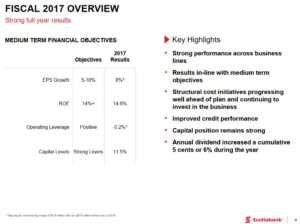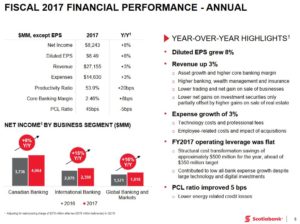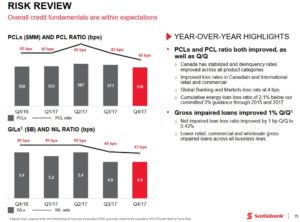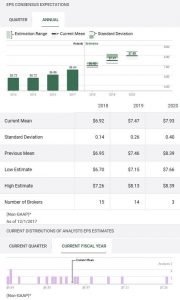Contents
 Summary
Summary
- BNS recently reported strong FY2017 results which coincided with a recommendation by PAA Research that investors short the Canadian banks.
- BNS generates 50+% of its revenue from Canada but its international operations are in 4 key countries where the GDP growth outlook is superior to that for Canada and the US.
- BNS continues to diversify internationally with the announcement of an offer to acquire the 7th largest bank in Chile for $2.9B. BNS currently owns the 6th largest bank in that country.
- A retracement in BNS’s stock price is likely to occur within the year but shorting BNS is a tough way to make money. I recommend a buy, hold, and reinvest the dividends strategy.
All figures are expressed in Canadian dollars.
Introduction
Recently PAA Research (“PAA”) based in Atlanta, Georgia released a report suggesting investors are being presented with an opportunity to profit by shorting (please listen to video) the Canadian banks.
Prior to reading this analysis on The Bank of Nova Scotia (TSX: BNS), you are encouraged to read my recent analysis on The Royal Bank of Canada (TSX: RY) in which I present my take on why shorting the Canadian banks stocks is not a recommended course of action.
Q4 2017 and FY2017 Results
BNS’s Q4 and FY2017 results presentation can be found here with supplementary detailed information available here. Readers are also strongly encouraged to read BNS’s Q4 News Release to obtain more granularity with respect to certain line items on the financial statements.

 Source: BNS's FY2017 and Q4 Results
Source: BNS's FY2017 and Q4 Results
Results were positively impacted by the non-recurring sale of the HollisWealth business and lower gains on sale of real estate. The sale of HollisWealth to Industrial Alliance Insurance and Financial Services Inc., however, did negatively impact fee and commission revenue but the net result from this sale was that it contributed 7% to net income growth.
HollisWealth was acquired by BNS in 2011 when it acquired DundeeWealth. Based on a strategic review of the bank’s operations a decision was made to sell this business and to redeploy the sale proceeds toward opportunities with greater growth and profitability potential (see FY2018 Outlook section below).
Considerable focus has been placed on the Canadian banks’ exposure to the Canadian consumer and the housing market. The following image from BNS’s FY2017 and Q4 presentation suggests the mortgage portfolio is being very well managed with BNS having ample room to manoeuvre in the event of a housing correction.

 Source: BNS's FY2017 and Q4 Results
Source: BNS's FY2017 and Q4 Results
FY2018 Outlook
BNS is Canada’s most international bank. Multiple international acquisitions have been made in Chile (Banco del Desarrollo in 2007), Colombia (Banco Colpatria in 2011), and in Peru, Costa Rica, and Panama.
In keeping with its strategy to diversify outside Canada, BNS has been focusing on growth markets in South America. Just recently BNS announced it had offered to acquire either 68% or 100% of Banco Bilbao Vizcaya Argentaria’s (NYSE: BBVA) majority stake in Chile’s 7th largest bank; BNS currently owns Chile’s 6th largest bank. This ~$2.9B acquisition would essentially double Scotiabank's market share in Chile to ~14% and would result in BNS becoming the 3rd largest private sector bank in the country.
 BNS will most likely need to raise equity for this acquisition and the amount to be raised will be determined on the percentage of BBVA to be acquired. If BNS acquires 100% of BBVA it is possible ~$1.4B in equity will need to be raised in order to keep capital ratios in line.
BNS will most likely need to raise equity for this acquisition and the amount to be raised will be determined on the percentage of BBVA to be acquired. If BNS acquires 100% of BBVA it is possible ~$1.4B in equity will need to be raised in order to keep capital ratios in line.
BNS has taken a different approach to international expansion relative to its Canadian peer group. While the 4 other major Canadian financial institutions have chosen to focus their expansion efforts in the US, BNS has chosen to focus on Central and South America; it already has a sizable presence in the Caribbean.
This strategy has worked out well for BNS. As evidenced from the chart below, growth in BNS’s key Central and South American markets have experienced superior GDP growth relative to Canada and the US.
 Source: BNS's FY2017 and Q4 Results
Source: BNS's FY2017 and Q4 Results
Just like all its Canadian counterparts, BNS is making considerable ongoing investments in technology and communication. These efforts should ultimately translate into improved operating efficiency, a superior customer experience, and internal sales coordination.
When you grow via acquisition you inevitably end up with duplication in a host of areas (branch network, back-end systems, employees, etc.); BNS has multiple back-end systems. Integrating a newly acquired bank is costly but at the same time opportunities are presented. In the case of call centres, for example, BNS may be able to have a call centre in Chile which would be able to handle the banks needs in Chile, Peru, and Colombia. The same could apply to Data Centres and other areas of the business.
Given BNS’s penchant for several broadly based acquisitions over the years relative to its peer group, I am of the opinion that BNS’s technology and communication and rationalization expenses will likely be at the upper end within the 5 major Canadian banks. Once many of the improvements / enhancements are made, however, BNS should experience benefits which will flow straight to the bottom line.
Although BNS’s sources of revenue are well diversified by business segment and geographic region, a large percentage of its business is generated from within Canada (50+% of revenue). As a result, BNS will experience the same challenges as its Canadian counterparts if economic conditions within the country turn negative. This would most likely result in a pullback in BNS’s stock price but I do not envision a correction to the extent PAA suggests.
Dividends, Dividend Yield, and Dividend Payout Ratio
BNS’s dividend history can be found here and here. As with the other major Canadian financial institutions, BNS froze its quarterly dividend during the Financial Crisis.
The next quarterly $0.79 dividend will be payable toward the end of January 2018. This will mark the second quarterly payment at this level.
If BNS decides to keep with its practice over the past several years of raising its quarterly dividend twice per year we can likely see a ~$0.81 dividend in Q2 and Q3 and a ~$0.83 dividend in Q4. This would result in a ~$3.24 annual dividend in 2018 which would represent a forward dividend yield of ~4% on the basis of the December 1, 2017 closing stock price of $81.84; stock screeners reflect a current dividend yield of ~3.86% in that they do not account for the highly probable dividend increases in 2018.
BNS’s dividend payout ratio is ~48% of adjusted EPS which is comparable to recent historical levels and those of its peers.
Valuation
The current mean FY2018 adjusted EPS estimate from various brokers is $6.92 with a very significant disparity in estimates.
Using the low ($6.70), mean ($6.92), and high ($7.26) adjusted EPS estimates and the current $81.84 stock price I get a forward adjusted PE of ~12.21, ~11.83, and ~11.27. These valuation levels exceed those of The Canadian Imperial Bank of Commerce (TSX: CM) (~11.24, ~10.79, and ~10.49) but are lower than those of RY (~12.94, ~12.57, and ~12.14). The reasoning for this is that the market views BNS’s franchise as being inferior to that of RY and superior to that of CM.
I view the projected adjusted EPS estimates reflected above as reasonable for a franchise of BNS’s quality.
Final Thoughts
In my opinion BNS has a lot going for it:
- A strong business mix with good momentum in domestic (50%+ of revenue) and international banking (~40% of revenue) – a single digit percentage is derived from the US;
- Aggressive expense management;
- A strong capital ratio (Common Equity Tier 1 ratio of 11.5%).
While a pullback in BNS’s stock price is a real possibility I recommend investors think long-term. Shorting BNS is not for the faint of heart. A buy, hold, and reinvest the dividends strategy has rewarded long-term BNS investors so far. This is unlikely to change in the foreseeable future.
I wish you much success on your journey to financial freedom.
Thanks for reading!
Note: I sincerely appreciate the time you took to read this post. As always, please leave any feedback and questions you may have in the “Contact Me Here” section to the right.
Disclaimer: I have no knowledge of your individual circumstances and am not providing individualized advice or recommendations. I encourage you not to make any investment decision without conducting your own research and due diligence. You should also consult your financial advisor about your specific situation.
Disclosure: I am long BNS, CM, and RY.
I wrote this article myself and it expresses my own opinions. I am not receiving compensation for it and have no business relationship with any company whose stock is mentioned in this article.
My Amazon picks.


